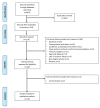Effect of Calorie Restriction and Intermittent Fasting Regimens on Brain-Derived Neurotrophic Factor Levels and Cognitive Function in Humans: A Systematic Review
- PMID: 38276070
- PMCID: PMC10819730
- DOI: 10.3390/medicina60010191
Effect of Calorie Restriction and Intermittent Fasting Regimens on Brain-Derived Neurotrophic Factor Levels and Cognitive Function in Humans: A Systematic Review
Abstract
Background: The potential positive interaction between intermittent fasting (IF) and brain-derived neurotrophic factor (BDNF) on cognitive function has been widely discussed. This systematic review tried to assess the efficacy of interventions with different IF regimens on BDNF levels and their association with cognitive functions in humans. Interventions with different forms of IF such as caloric restriction (CR), alternate-day fasting (ADF), time-restricted eating (TRE), and the Ramadan model of intermittent fasting (RIF) were targeted. Methods: A systematic review was conducted for experimental and observational studies on healthy people and patients with diseases published in EMBASE, Scopus, PubMed, and Google Scholar databases from January 2000 to December 2023. We followed the Preferred Reporting Items for Systematic Reviews and Meta-Analysis statements (PRISMA) for writing this review. Results: Sixteen research works conducted on healthy people and patients with metabolic disorders met the inclusion criteria for this systematic review. Five studies showed a significant increase in BDNF after the intervention, while five studies reported a significant decrease in BDNF levels, and the other six studies showed no significant changes in BDNF levels due to IF regimens. Moreover, five studies examined the RIF protocol, of which, three studies showed a significant reduction, while two showed a significant increase in BDNF levels, along with an improvement in cognitive function after RIF. Conclusions: The current findings suggest that IF has varying effects on BDNF levels and cognitive functions in healthy, overweight/obese individuals and patients with metabolic conditions. However, few human studies have shown that IF increases BDNF levels, with controversial results. In humans, IF has yet to be fully investigated in terms of its long-term effect on BDNF and cognitive functions. Large-scale, well-controlled studies with high-quality data are warranted to elucidate the impact of the IF regimens on BDNF levels and cognitive functions.
Keywords: BDNF; Ramadan fasting; cognitive function; intermittent fasting; metabolic condition.
Conflict of interest statement
The authors declare no conflict of interest.
Figures



Similar articles
-
Weight loss interventions for chronic asthma.Cochrane Database Syst Rev. 2012 Jul 11;2012(7):CD009339. doi: 10.1002/14651858.CD009339.pub2. Cochrane Database Syst Rev. 2012. PMID: 22786526 Free PMC article.
-
[Volume and health outcomes: evidence from systematic reviews and from evaluation of Italian hospital data].Epidemiol Prev. 2013 Mar-Jun;37(2-3 Suppl 2):1-100. Epidemiol Prev. 2013. PMID: 23851286 Italian.
-
Effects of Intermittent Fasting and Calorie Restriction on Exercise Performance: A Systematic Review and Meta-Analysis.Nutrients. 2025 Jun 13;17(12):1992. doi: 10.3390/nu17121992. Nutrients. 2025. PMID: 40573103 Free PMC article. Review.
-
Education support services for improving school engagement and academic performance of children and adolescents with a chronic health condition.Cochrane Database Syst Rev. 2023 Feb 8;2(2):CD011538. doi: 10.1002/14651858.CD011538.pub2. Cochrane Database Syst Rev. 2023. PMID: 36752365 Free PMC article.
-
Systemic pharmacological treatments for chronic plaque psoriasis: a network meta-analysis.Cochrane Database Syst Rev. 2021 Apr 19;4(4):CD011535. doi: 10.1002/14651858.CD011535.pub4. Cochrane Database Syst Rev. 2021. Update in: Cochrane Database Syst Rev. 2022 May 23;5:CD011535. doi: 10.1002/14651858.CD011535.pub5. PMID: 33871055 Free PMC article. Updated.
Cited by
-
Intermittent fasting as a treatment for obesity in young people: a scoping review.NPJ Metab Health Dis. 2024;2(1):39. doi: 10.1038/s44324-024-00041-2. Epub 2024 Dec 30. NPJ Metab Health Dis. 2024. PMID: 39744147 Free PMC article.
-
Intermittent Fasting in Youth: A Scoping Review.Res Sq [Preprint]. 2024 Jul 1:rs.3.rs-4524102. doi: 10.21203/rs.3.rs-4524102/v1. Res Sq. 2024. Update in: NPJ Metab Health Dis. 2024;2(1):39. doi: 10.1038/s44324-024-00041-2. PMID: 39011109 Free PMC article. Updated. Preprint.
-
A perspective on intermittent fasting and cardiovascular risk in the era of obesity pharmacotherapy.Front Nutr. 2025 Jan 17;12:1524125. doi: 10.3389/fnut.2025.1524125. eCollection 2025. Front Nutr. 2025. PMID: 39895836 Free PMC article.
-
The Sex-Dependent Ameliorative Effect of Intermittent Fasting on Urinary System Functions in Genetic Absence Epileptic Rats.Biology (Basel). 2025 Feb 4;14(2):158. doi: 10.3390/biology14020158. Biology (Basel). 2025. PMID: 40001926 Free PMC article.
-
Exploring mood and anxiety disturbances across Ramadan: a comparative study of Saudi medical students before, during, and after fasting.Front Psychol. 2025 Jun 25;16:1570557. doi: 10.3389/fpsyg.2025.1570557. eCollection 2025. Front Psychol. 2025. PMID: 40636047 Free PMC article.
References
Publication types
MeSH terms
Substances
LinkOut - more resources
Full Text Sources
Research Materials
Miscellaneous

